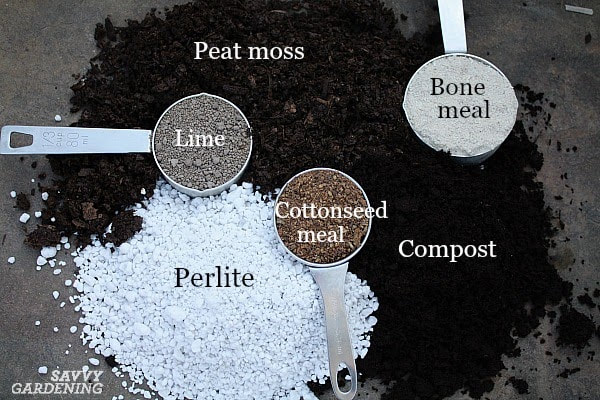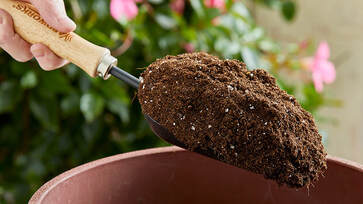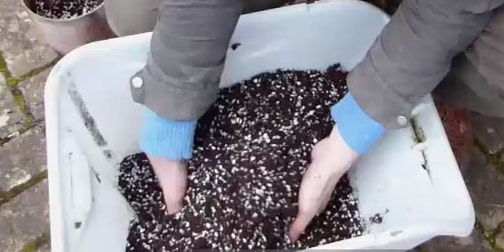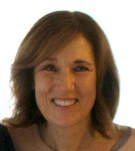|
As temperatures rise, people like us (avid gardeners) flee to warm and inviting greenhouses to herald the beginning of spring. Filling your pots with the proper soil mixture ensures long blooms and healthy potted plants. We’ve spent several blogs on container gardens (link) and design. In this blog, we will explain what soil is best for potted plants and how to purchase or create your own. Potting Soil Myth “Potting soil” actually doesn’t contain soil. It is a soilless blend of ingredients used to grow plants. Regardless of what you are planting, the differences between good quality potting mixes and soil are:
In general, soil straight out of your garden is too heavy, drowns roots and prevents air circulation in pots. Tip for success: Do not buy bagged garden soil or use soil taken from or intended for garden planting. Potting soil and garden soil are not interchangeable. Before purchasing or making your own potting mix, it is always a good idea to start with these questions:
Why Potting Mix Matters Potting mixes are lightweight, retain moisture, and they supply plenty of air space around the roots. Air space is actually one of the most critical aspects of potting mix. If the roots don’t have enough air, a plant usually doesn’t survive. Although the ingredients tend to vary, good mixes always contain an organic component (peat moss, compost, bark), vermiculite or perlite (to help retain moisture), sand, nutrients and limestone. Some contain fertilizer or moisture-retaining treatments, usually indicated on the label. Knowing what is in the potting mix is key to determining whether it will be a good match for the plants you are trying to grow. General potting mixes will work fine for most annuals and vegetables grown in containers, but they may hold too much moisture for orchids, succulents or cacti. Specialty mixes are sold for these plants and, while not absolutely necessary, can provide benefits. (Emma Erler, a landscape and greenhouse field specialist at the University of New Hampshire Extension) Potting Mix Ingredients Educating yourself on the basic ingredients is a good way to determine the best potting mix for your needs.
For a review of the best gardening soils to purchase, try the links below. Nowadays, it is hard to decipher whether the review is being sponsored and if reviews are honest. Regardless, these sites contain some useful information. There are some excellent quality bagged soils available. Just make sure to read the labels to ensure the ingredients match your plant’s needs. If you are a DIY, you can easily make your own potting mix, and even include children in the process. Be sure to know what you plan to grow. Use the recipes to create a mix to best care for your plant. Happy Spring Planting! 6 DIY Potting Mix Recipes from Savvy Gardening General potting soil recipe for flowers, tropicals, and vegetables
6 gallons sphagnum peat moss or coir fiber 4.5 gallons perlite 6 gallons compost 1/4 cup lime (if using peat moss) 1.5 cups of the DIY container fertilizer blend found below OR 1 & 1/2 cups of any granular, complete, organic fertilizer. DIY container fertilizer blend Mix together 2 cups rock phosphate 2 cups greensand ½ cup bone meal ¼ cup kelp meal Potting soil recipe for potted trees and shrubs 3 gallons compost 2.5 gallons coarse sand 3 gallons sphagnum peat moss or coir fiber 2.5 gallons composted pine bark 3 gallons perlite 2 TBSP of lime (if using peat moss) 1 cup granular, organic fertilizer (or 1 cup of the DIY container fertilizer blend found above) 1/4 cup organic cottonseed meal, if growing acid-loving trees and shrubs Potting soil recipe for succulents and cactus 3 gallons sphagnum peat moss or coir fiber 1 gallon perlite 1 gallon vermiculite 2 gallons coarse sand 2 TBSP lime (if using peat moss) Potting soil recipe for seed starting 2 gallons sphagnum peat moss or coir fiber 2 gallons vermiculite 1 gallon coarse sand 3 TBSP lime (if using peat moss)
0 Comments
Your comment will be posted after it is approved.
Leave a Reply. |
Thank you for finding us! Holly and I have collaborated to bring you informative, fun, and seasonal garden inspiration blogs.
Subscribe to receive our blogs on the 1st and 15th of the month--Gwen Follow my landscape & garden design Pinterest Page to see more pics, inspiration and Gwen's home garden journey!
AuthorsGwen Wisniewski: Landscape and Garden Designer. Contact me. Let me help you integrate these garden inspirations. Choose the links below to find out more about my landscape design service or to make an appointment. |






 RSS Feed
RSS Feed